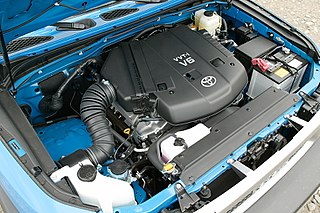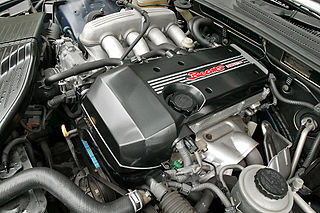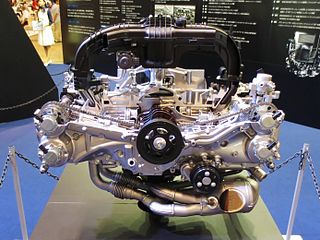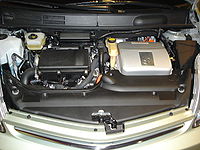
The Toyota Vitz is a subcompact car produced by the Japanese automobile manufacturer Toyota from 1999 to 2019 in a three- or five-door hatchback body styles. The "Vitz" nameplate was used consistently in Japan, while most international markets received the same vehicle as the Toyota Yaris, or as the Toyota Echo in some markets for the first generation. The Vitz was available in Japan from Toyota's Netz Store dealerships. Toyota began production in Japan and later assembled the vehicle in other Asian countries and in France.

The Toyota A Series engines are a family of inline-four internal combustion engines with displacement from 1.3 L to 1.8 L produced by Toyota Motor Corporation. The series has cast iron engine blocks and aluminum cylinder heads. To make the engine as short as possible, the cylinders are siamesed.

The Toyota AZ engine family is a straight-4 piston engine series. The AZ series uses an aluminium engine block with cast iron cylinder liners and aluminium DOHC cylinder head. The engine series features many advanced technologies including slant-squish combustion chambers, offset cylinder and crank centers, and the VVT-i continuously variable intake valve timing system. The aluminium engine measures 626 mm (24.6 in) long, 608 mm (23.9 in) wide, and 681 mm (26.8 in) tall.

The Toyota GR engine family is a gasoline, open-deck, piston V6 engine series. The GR series has a 60° die-cast aluminium block and aluminium DOHC cylinder heads. This engine series also features 4 valves per cylinder, forged steel connecting rods and crankshaft, one-piece cast camshafts, a timing chain, and a cast aluminium lower intake manifold. Some variants use multi-port fuel injection, some have D4 direct injection, and others have a combination of direct injection and multi-port fuel injection or D4-S.

The Toyota S Series engines are a family of straight-four petrol engines with displacements between 1.8 and 2.2 litres, produced by Toyota Motor Corporation from January 1980 to August 2007. The S series has cast iron engine blocks and aluminium cylinder heads.

The Toyota E engine family is a straight-four piston engine series, and uses timing belts rather than chains. The E engines were the first multi-valve engines from Toyota designed with economy, practicality and everyday use in mind. Like many other Toyota engines from the era, the E engine series features a cast iron block, along with an aluminium cylinder head. E engines are lighter than earlier Toyota engines, due to the hollow crankshaft, thinned casting of the cylinder block, and several other reductions in auxiliaries as well as in the engine itself. Carbureted versions include a newly designed, variable-venturi carburetor. All of these changes improved economy and emissions. The members of the E engine family, range from 1.0 L to 1.5 L. The E family supplanted the K engines in most applications. A large number of parts in the E engine series are interchangeable between each other.

The Toyota KR engine family is a straight-3 piston engine, designed by Daihatsu, a subsidiary of Toyota. The 1KR series uses aluminium engine blocks and chain driven DOHC cylinder heads. It uses multi-point fuel injection, and has 4 valves per cylinder. Some versions have VVT-i variable valve timing. The engine is exceptionally light: 69 kg (152 lb) with all ancillaries.

The Toyota UR engine family is a 32-valve dual overhead camshaft V8 piston engine series which was first introduced in 2006, as the UZ series it replaced began phasing out. Production started with the 1UR-FSE engine with D-4S direct injection for the 2007 Lexus LS. The series launched with a die-cast aluminum engine block, aluminum cylinder heads and magnesium cylinder head covers. All UR engines feature variable valve timing for both intake and exhaust cams or Dual VVT-i. Timing chains are used to drive the camshafts. The UR engine has been produced in 4.6, 5.0, and 5.7-liter displacement versions.
The Toyota ND is an inline-four diesel engine used for Toyota models in various markets including Japanese, Indian and European ones.
The Toyota N engine is a diesel engine produced by Toyota between 1986 and 1999.

The ZR engine is a family of straight-four 16-valve all-aluminum and water cooled gasoline engines with a die-cast aluminum block and variable valve timing developed by Toyota Motor Corporation, produced from 2007. Engines displace from 1.6 to 2.0 liters. Most engines in this family are equipped with Toyota's dual VVT-i technology that optimizes both intake and exhaust valve timing. This engine family is also the first to use Toyota's Valvematic system, first appearing on the Noah and Voxy in 2007 and then the European Avensis in 2009.

The Toyota SZ engine family is a series of straight-4 piston engines with a forward-facing exhaust. Toyota Motor Manufacturing (UK) in Deeside produces SZ engines for the Yaris. All three types of the SZ engine are built in Tianjin FAW Toyota Engine Co., Ltd. (TFTE) Plant No. 1 in Xiqing District, Tianjin, China. The 2SZ-FE and 3SZ-FE variations are also manufactured by PT Astra Daihatsu Motor's Karawang Engine Plant in Indonesia.
The ToyotaC engine family was a series of inline-4 diesel engines. There were two earlier generations of an engine Toyota named as the "Type C". The first generation was introduced in 1940 as a modification of the Type A engine. This first "Type C" was installed in the Toyota AE. The second generation was the first diesel engine at 1500cc used in the CS20 series 1959 Toyota Crown in October 1959. Japanese market vehicles with diesel engines were exclusive to Toyota Japan dealerships called Toyota Diesel Shop locations from 1979 until the dealership was cancelled in 1988.

The AR engine family is an Inline-4 piston engine series by Toyota, first introduced in 2008 for the RAV4, and subsequently for the Highlander, Venza, Camry and Scion tC.

The Toyota NR engine family is a series of small inline-four piston engines designed and manufactured by Toyota, with capacities between 1.2 and 1.5 litres.

The Subaru FB engine is the third and current generation of gasoline boxer-4 engine used in Subaru automobiles, and was announced on 23 September 2010. It follows the previous generation EJ-series engine which was introduced in 1989 and the first generation EA-series which was introduced in 1966. By increasing piston stroke and decreasing piston bore, Subaru aimed to reduce emissions and improve fuel economy, while increasing and broadening torque output compared to the EJ-series.

The Subaru FA engine is a gasoline boxer-4 engine used in Subaru and Toyota automobiles. It is a derivative of the FB engine, with efforts to reduce weight while maintaining durability as the main design goals. Although the FA and FB engines share a common platform, the FA shares very little in dedicated parts with the FB engine, with a different block, head, connecting rods, and pistons.

The Toyota GD engine series is a diesel engine produced by Toyota which appeared in 2015. It replaced the Toyota KD engine series as a diesel engine series mainly oriented to body-on-frame vehicles. The GD engine featured Economy with Superior Thermal Efficient Combustion (ESTEC) technology. Toyota claims they have a maximum thermal efficiency of 44 percent, "top class" at the time of introduction.

The Toyota Corolla (E210) is the twelfth generation of the Corolla, a compact car (C-segment) manufactured by Toyota. Introduced in 2018, this generation has also grown to include hatchback and estate configurations in addition to the saloon (sedan).

The Suzuki K engine family is a series of automobile engines from Suzuki, introduced in 1994. Displacements range from 0.7 L to 1.5 L. All engines have aluminium cylinder blocks with three or four cylinders in-line. Cylinder heads have two overhead camshafts, driven by chain, and four valves per cylinder. Fuel is gasoline/petrol, metered by multipoint fuel injection or direct injection. Some variants are turbocharged.






















